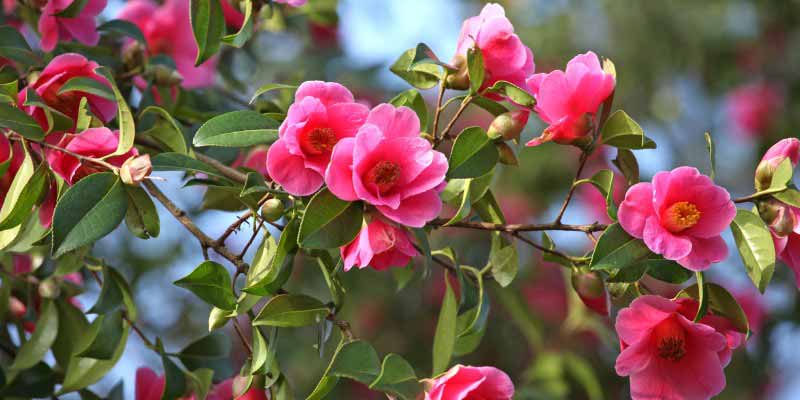Over time, your camellia, once lush, has lost its splendour. A somewhat bare habit and a less harmonious silhouette are signs that rejuvenation pruning is needed. If your camellia is really in poor condition – too dense, thinning at the base or producing very few flowers – a drastic prune may be necessary to give it a new lease of life. Discover how a severe but respectful prune can revive a camellia and restore its former glory !
What is lifespan of a camellia?
A well-cared-for camellia can live for several decades, even a century! These evergreen bushes are renowned for their longevity, but appearance and vigour can deteriorate over time. If neglected, they can thin out at the base, become less floriferous, grow too densely or lose structural balance.

When should you consider a drastic prune?
- Aging camellia: If your bush has become unattractive, with many bare branches and sparse foliage.
- Weakened camellia: If the plant appears in poor health or no longer produces new shoots.
- Rejuvenation: When you want to restore a more compact, dense structure to the bush.
When to prune an old camellia to rejuvenate it?
If your camellia flowers less, or if its flowers are smaller and sparser, thins at the base, becomes untidy, shows dead wood or generally seems weakened, it is time to rejuvenate it. A drastic prune may seem radical, but done correctly it can bring your bush back to life. To limit stress on your venerable camellia, carry out rejuvenation pruning at end of winter, after flowering, on a sunny day when risk of frost has passed. To avoid weakening the bush, it is preferable to spread pruning over two to three years, removing gradually one third to one half of branches each year. This way, you will not prune more than one third of plant at once.
⛔ To avoid: Do not prune in autumn or winter, as this may disrupt flowering for following year.

Necessary equipment
- gardening gloves
- A pruning shear, well sharpened and disinfected with methylated spirits to avoid transmitting diseases to camellia
- A branch cutter or a pruning saw, also clean
- A wound-sealing compound
How to bring a camellia back to life?
Step-by-step technique
- Identify main branches to keep and those to remove
- With pruning shear or branch cutter, remove all dead, damaged or diseased branches (they are almost black, bear no leaves and wood remains brown even when scraped with a fingernail; these shoots are dead), cutting them back to their base.
- Remove branches that cross or grow inwards
- With branch cutter or handsaw, shorten main branches to about 50 cm above soil. This may seem extreme, but it is necessary to stimulate vigorous regrowth. Be sure to cut just above a bud or a small lateral branch. Prune on a slant: a diagonal cut at roughly 45 degrees promotes better healing by exposing less surface directly to weather. This reduces risk of rot and infection. If main branches seem hollow, rotten or very weak, it is sometimes better to cut back to base and let basal shoots regrow.
- After shortening one third of large branches, lightly prune secondary branches to obtain a balanced shape.

Care and advice after pruning
Pay particular attention to camellia recovery:
- Apply a wound-sealing compound to pruning wounds, this helps prevent insect intrusion or disease.
- A drastic prune often opens interior of bush. This improves ventilation, but avoid exposing trunk or large branches suddenly to direct sun. Camellia prefers shaded or semi-shaded environment, and sunscald can damage bark. Temporarily plant tall annuals around base to protect from excessive exposure.
- Spread some heather soil at foot of bush to encourage rapid, healthy growth.
- Before summer, apply a layer of organic mulch (pine bark, pine needles) to maintain soil acidity and conserve moisture.
- Once this pruning is done, leave camellia alone for at least one year to allow regeneration. Only remove dead or damaged branches as they appear, without attempting to prune again straight away.
- After a drastic prune, camellia may produce basal shoots or very vigorous shoots. Leave a few to renew bush and thicken base, but remove those that seem too weak or poorly placed.

































Comments